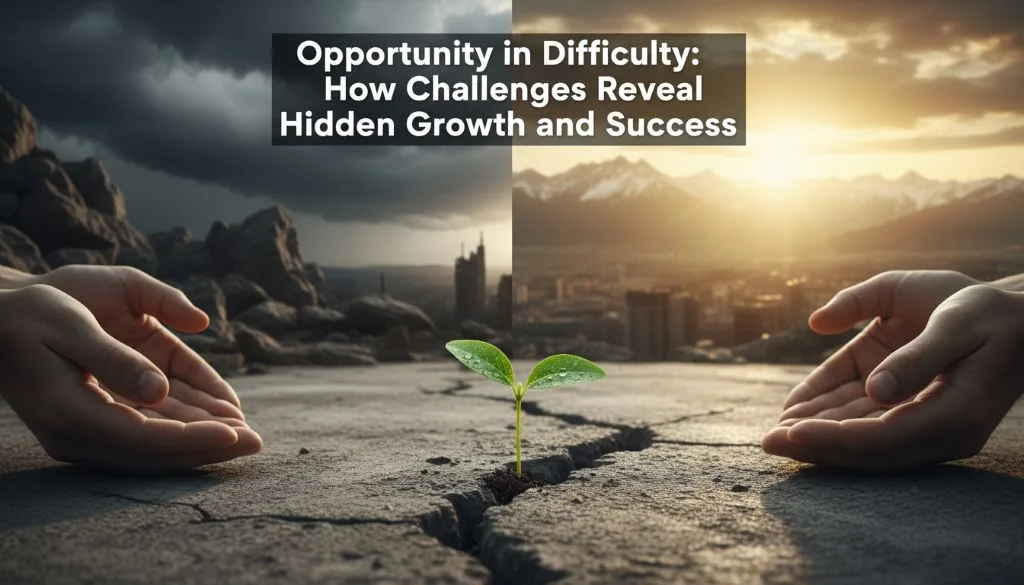Views: 0
Discover how to find opportunity in difficulty, turn challenges into growth, and thrive through adversity with insights from Einstein’s timeless wisdom.
3 Key Takeaways:
- Every challenge hides the seed of transformation — adversity can become your greatest opportunity.
- Shifting mindset from resistance to discovery unlocks new paths for growth, creativity, and meaning.
- The wisdom of “opportunity in difficulty” applies universally — from personal setbacks to global innovation.
Table of Contents
- 1 Introduction to Opportunity in Difficulty
- 2 Personal Growth Perspective: Finding Opportunity In Crisis
- 3 Professional & Leadership Insight: Turning Challenges Into Opportunities
- 4 Philosophical & Psychological Depth: Why Difficulty Breeds Opportunity
- 5 Cultural & Historical Connection: Origins And Global Context
- 6 Practical Application: How To See Opportunity In Difficulty
- 7 Conclusion On Opportunity In Difficulty
- 8 Frequently Asked Questions (FAQs) About Opportunity In Difficulty
Introduction to Opportunity in Difficulty
Albert Einstein, one of history’s most profound thinkers, once said: “In the middle of difficulty lies opportunity.”
This statement distills a truth that transcends time and circumstance. Whether in personal struggle, professional crisis, or collective hardship — the hardest moments often become turning points for growth, innovation, and self‑understanding.
READ ALSO: Your Best Teacher Is Your Last Mistake: Turn Failure Into Fuel
Einstein’s insight wasn’t born from theory but from experience. His life was marked by rejection, isolation, and intense political turmoil. Yet those difficulties cultivated the very curiosity and resilience that defined his scientific genius. This quote invites us to adopt a similar lens — to perceive adversity not as an obstacle, but as an invitation.
In this article, we’ll explore what “opportunity in difficulty” truly means across personal, professional, and philosophical dimensions. We’ll uncover scientific, psychological, and historical evidence showing why struggle often precedes progress — and how you can practically live by this timeless truth.
Personal Growth Perspective: Finding Opportunity In Crisis
From Setback to Strength: The Psychology of Resilience
Personal crises often carry a paradox: they break us open in order to rebuild us stronger. Research in post‑traumatic growth shows that individuals who face significant adversity often report deeper appreciation for life, improved relationships, and new priorities afterward (Tedeschi & Calhoun, 2004).
When you encounter hardship, your mind initially experiences chaos — uncertainty, loss of control, fear. But as you adapt, new pathways emerge. This adaptive process is the very essence of opportunity in difficulty. The challenge becomes a catalyst for self‑discovery.
Mindset: Reframing Hardship as Hidden Potential
According to Carol Dweck’s Growth Mindset theory, believing that abilities can be developed transforms how we interpret failure (Dweck, 2006). Instead of seeing difficulty as defeat, you see it as data — feedback for improvement.
“Every difficulty holds a lesson — not just about what went wrong, but about what’s possible next.”
Practical steps to apply this mindset:
- Name the lesson: Ask, “What is this challenge teaching me right now?”
- Shift your lens: Replace “Why me?” with “What now?”
- Celebrate micro‑growth: Recognize progress, no matter how small.
Finding Silver Linings in Hardship
The Japanese art of kintsugi — repairing broken pottery with gold — beautifully symbolizes this principle. By highlighting cracks instead of hiding them, we celebrate resilience and imperfection. Similarly, your personal scars can become stories of transformation and purpose.
Professional & Leadership Insight: Turning Challenges Into Opportunities
Adversity as a Catalyst for Innovation
In business and leadership, the phrase “opportunity in difficulty” resonates deeply. Many groundbreaking innovations emerged in times of crisis.
- Airbnb was founded during the 2008 financial crash when its founders struggled to pay rent.
- Apple’s iPod emerged after a period of stagnation and management upheaval.
- COVID‑19 accelerated digital transformation globally, from remote work to telemedicine.
The key lies in perspective: leaders who see crisis as a proving ground instead of a dead end often pioneer the next wave of change (Harvard Business Review, 2020).
Strategic Leadership Through Uncertainty
Effective leaders transform problems into possibilities by:
- Acknowledging reality — never sugarcoating the challenge.
- Vision casting — reframing obstacles into opportunities for team growth.
- Empowering experimentation — encouraging creative risks during chaos.
When you embrace difficulty with composure and curiosity, you convert uncertainty into strategy.
Workplace Resilience: Growth Through Adversity
Organizations that foster psychological safety — environments where employees feel free to fail and learn — outperform rigid cultures (Edmondson, 2018). Building teams that reframe challenges as developmental opportunities drives engagement and long‑term innovation.
Philosophical & Psychological Depth: Why Difficulty Breeds Opportunity
The Stoic Connection
Stoic philosophers like Marcus Aurelius taught that obstacles are not hindrances but pathways: “The impediment to action advances action. What stands in the way becomes the way.” (Aurelius, Meditations).
Einstein’s worldview carried this Stoic flavor — seeing difficulty as nature’s invitation to evolve.
Logotherapy and Meaning in Suffering
Viktor Frankl, a Holocaust survivor and psychiatrist, proposed that humans can endure almost any “how” if they have a “why.” His theory of meaning through suffering (Frankl, 1959) mirrors Einstein’s insight: in struggle lies meaning — and meaning itself is life’s greatest opportunity.
Neuroscience of Challenge
Modern neuroscience supports this. When we encounter difficulty, the brain’s prefrontal cortex and anterior cingulate cortex activate — areas responsible for learning and problem‑solving (Yerkes & Dodson, 1908).
This means challenge literally rewires your brain for growth.
Cultural & Historical Connection: Origins And Global Context
Einstein’s quote emerged in a century marked by wars, displacement, and scientific revolution. His genius thrived despite — and often because of — constraint. Exiled from Nazi Germany, he turned adversity into discovery, ultimately shaping modern physics.
Across cultures, similar wisdom echoes:
- Chinese Proverb: “A gem cannot be polished without friction, nor a man perfected without trials.”
- African Proverb: “Smooth seas do not make skillful sailors.”
- Buddhist Teaching: Suffering (dukkha) is a source of awakening and compassion.
Throughout history, the human story advances through hardship. Civilization’s leaps — fire, art, flight, medicine — arose not from comfort but from necessity. As Einstein noted, “In the middle of difficulty lies opportunity” because human potential reveals itself under pressure.
Practical Application: How To See Opportunity In Difficulty
- Practice Cognitive Reframing
Consciously reinterpret setbacks. When faced with hardship, ask:
- What skill is this experience demanding of me?
- What strength might this reveal that I haven’t used yet?
- Build Emotional Agility
Psychologist Susan David emphasizes emotionally agile thinking — acknowledging emotion without being ruled by it (David, 2016). This helps you stay grounded and flexible amid storms.
- Apply the “Opportunity Audit”
After any challenge, run this 3‑step checklist:
- What went wrong? (Facts)
- What did I learn? (Reflection)
- What can I pivot toward? (Action)
- Embrace the Growth Cycle
Remember:
Discomfort → Awareness → Adaptation → Opportunity.
You can’t skip steps. Difficulty is not detour; it’s direction.
- Create Daily Micro‑Challenges
Build resilience like a muscle:
- Try one uncomfortable task daily.
- Write one lesson from failure weekly.
- Share one story of growth monthly.
Over time, your mind normalizes difficulty and reflexively searches for opportunity.
Conclusion On Opportunity In Difficulty
Life’s toughest seasons are often life’s richest teachers. Einstein’s words remind us that opportunity and difficulty are not opposites — they are companions.
The same tension that creates fear also forges innovation, empathy, and depth.
Whether you’re rebuilding after loss, leading through crisis, or simply navigating daily chaos, remember this:
Difficulty is not your enemy; it’s your sculptor.
If you learn to see through the storm instead of flee from it, you transform survival into strength — and challenge into change.
REFERENCES
- David, S. (2016). Emotional Agility: Get Unstuck, Embrace Change, and Thrive in Work and Life. Avery.
- Dweck, C. (2006). Mindset: The New Psychology of Success. Random House.
- Edmondson, A. C. (2018). The Fearless Organization: Creating Psychological Safety in the Workplace for Learning, Innovation, and Growth. Wiley.
- Frankl, V. E. (1959). Man’s Search for Meaning. Beacon Press.
- Harvard Business Review. (2020). Leading Through Crisis: Innovation Under Pressure. Retrieved from https://hbr.org
- Isaacson, W. (2007). Einstein: His Life and Universe. Simon & Schuster.
- Tedeschi, R. G., & Calhoun, L. G. (2004). Posttraumatic Growth: Conceptual Foundations and Empirical Evidence. Psychological Inquiry, 15(1), 1–18.
- Yerkes, R. M., & Dodson, J. D. (1908). The Relation of Strength of Stimulus to Rapidity of Habit-Formation. Journal of Comparative Neurology and Psychology, 18(5), 459–482.
Frequently Asked Questions (FAQs) About Opportunity In Difficulty
| Question | Answer |
|---|---|
| What does “opportunity in difficulty” really mean? | It means every challenge hides potential for growth or success. Instead of focusing on problems, look for what new skills, perspectives, or opportunities emerge from adversity. |
| How can I find opportunity in difficult times? | Begin by shifting perspective—ask, “What can I learn here?” Use adversity as a catalyst for creativity, adaptability, and long-term growth. Difficult times sharpen resilience and innovation. |
| Can challenges create opportunities for growth? | Yes. Challenges push you beyond comfort zones, developing strength, discipline, and new thinking. Many innovators and leaders turned crisis into creativity and growth. |
| Why is adversity important for personal development? | Adversity builds resilience and emotional intelligence. Facing difficulty teaches perseverance, leadership, and adaptability—qualities essential for lifelong growth and achievement. |
| What’s the silver lining in hardship? | Hardship reveals hidden strengths, purpose, and empathy. It’s through struggle that new direction, character, and appreciation for life emerge. |
| How can leaders turn challenges into opportunities? | Great leaders reframe challenges as innovation moments. They empower teams to experiment, adapt, and build resilience during change—turning crisis into creativity. |
| How do I stay positive during hard times? | Practice gratitude, mindfulness, and small daily achievements. Focusing on progress rather than pain helps you maintain hope and spot opportunities in difficulty. |
| Is finding opportunity in crisis a skill? | Yes. It’s a mindset trained through reframing, reflection, and resilience. You can learn to see crisis as a space for creativity and reinvention. |
| Why is “opportunity in difficulty” timeless wisdom? | Because across cultures and history, humans evolve through struggle. Adversity drives innovation, wisdom, and transformation, making this concept universally true. |
| How does growth through adversity shape success? | Overcoming adversity builds confidence and resourcefulness. Success stories often begin with failure turned into focus and opportunity. |
| How can I discover the silver lining in hardship? | Reflect on what the experience is teaching you. Ask “What new strength or awareness does this bring?” Every hardship contains growth potential. |
| How did Einstein define opportunity in difficulty? | Einstein believed that challenges spark discovery. His quote “In the middle of difficulty lies opportunity” shows how struggle fuels insight and innovation. |
| Can professional setbacks lead to opportunity? | Yes. Setbacks often redirect attention to unseen opportunities—new ideas, roles, or solutions—that might not appear without initial failure. |
| How can businesses find opportunity during crises? | By innovating under constraint. Many startups and digital trends arose during recessions because necessity drives creativity and reinvention. |
| What’s a practical way to see opportunity in difficulty daily? | Keep a “Challenge Journal”—document what went wrong, what you learned, and what action you’ll take next. This converts difficulty into directed opportunity. |







